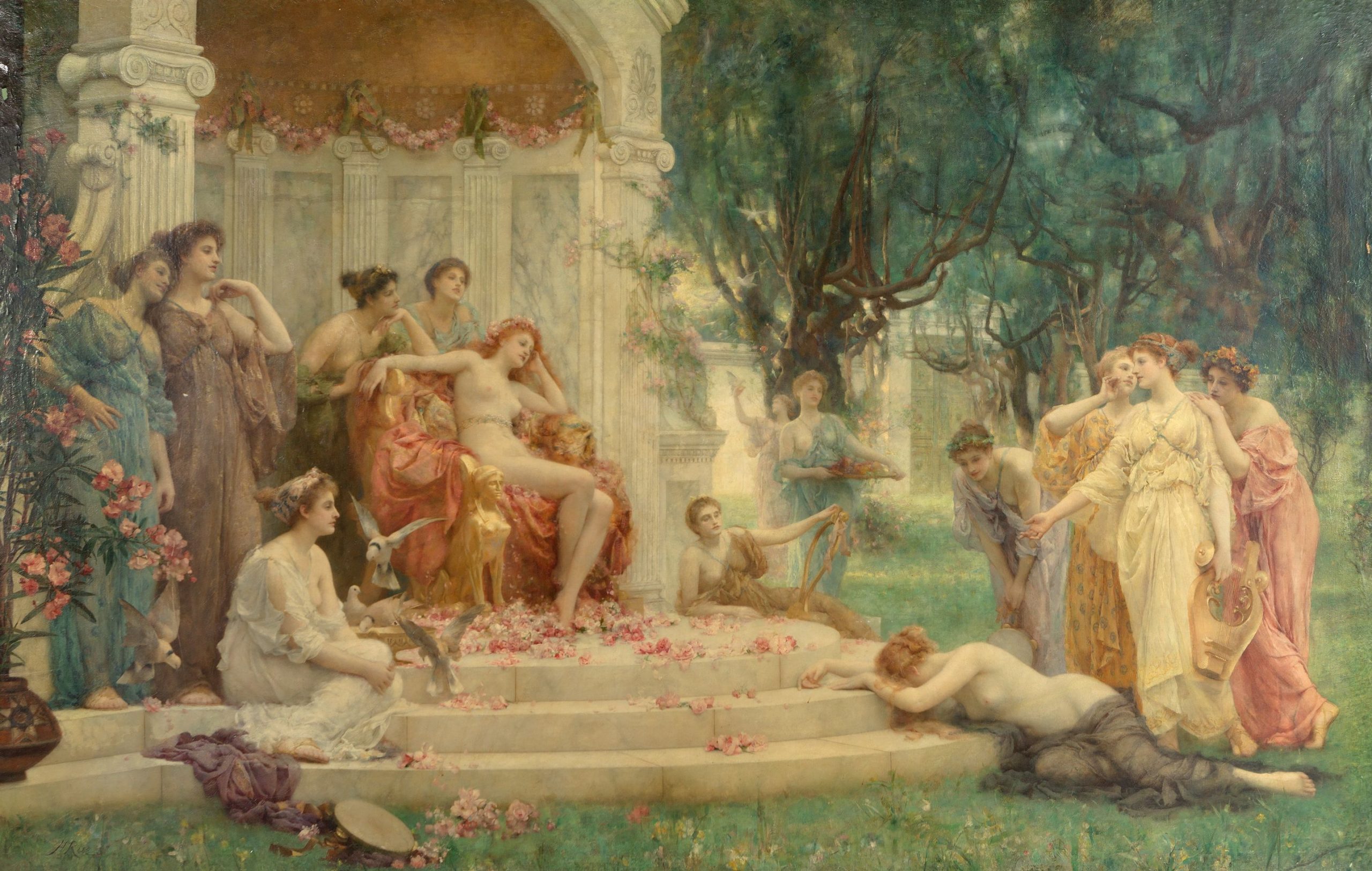Summary
- The Mother: William-Adolphe Bouguereau’s The Motherland depicts a woman surrounded by children, who evokes the essence of maternal strength.
- The Daughter: As suggested by the title of Jacques Joseph Tissot’s The Warrior’s Daughter, the painting focuses on the dutiful caretaker, depicted with dignity and power.
- The Sentinel: Herbert James Draper’s The Gates of Dawn depicts Eos, the goddess of Dawn, who stands tall and proud, holding open the heavenly gates.
- The Judge: Fayzullah’s A Blindfolded Suitor is Brought Before a Princess symbolizes the control women had at the Mughal court.
- The Mystery: Sir Frederic Leighton’s A Roman Lady presents an Italian model, Anna Risi, with a confident and mysterious gaze.
- The Protectors: Orazio Gentileschi’s The Finding of Moses depicts a group of women, who bravely and compassionately try to protect the infant Moses.
- The Queen: Herbert Gustav Schmalz’s Queen Zenobia’s Last Look Upon Palmyra shows the final moments of the proud Queen Zenobia of Palmyra.
The Mother
William-Adolphe Bouguereau was a respected French academic painter of the late 19th century. He was renowned for his interpretations of mythological and classical subjects. While most of his female forms bore a recognizable pre-pubescent naivety, the main figure of this composition stands apart from Bouguereau’s typical female figures. This painting was exhibited at the Paris Salon in 1883.
The Motherland is set within Bouguereau’s typical idealized landscape and depicts a woman in the center of the frame. She sits on a stone platform or pedestal with a group of young children vying for her attention. She appears poised, unfathomable, and unperturbed by the cacophony of children that surround her. Furthermore, her presence evokes the essence of Gaia. One cannot guess what is on her mind, but also cannot help but be in absolute reverence of her commanding presence.
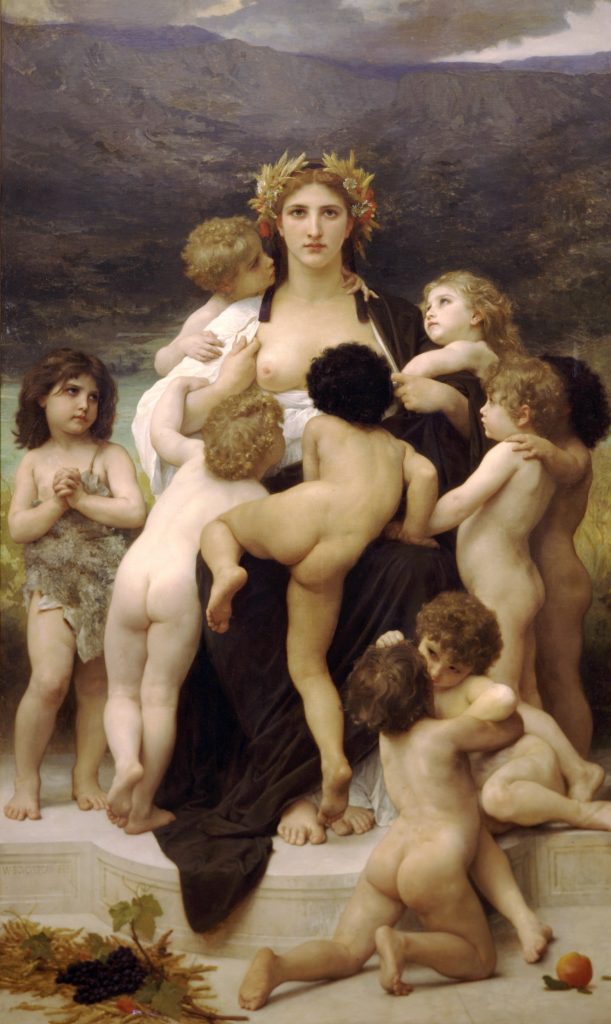
Powerful Women in Painting: William-Adolphe Bouguereau, The Motherland, ca. 1883. Sotheby’s, New York, NY, USA. Wikimedia Commons (public domain).
The Daughter
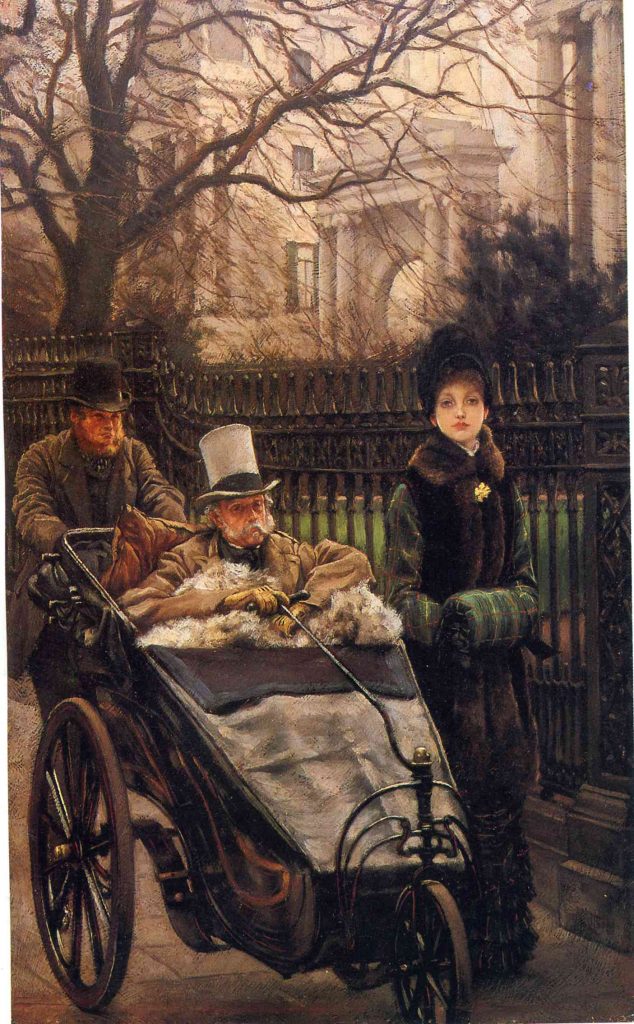
Powerful Women in Painting: James Tissot, The Warrior’s Daughter, or The Convalescent, ca. 1878, Manchester Art Gallery, Manchester, UK. Wikiart.
French artist Jacques Joseph Tissot was known for his genre paintings of fashionably dressed women engaged in mundane activities. After a successful career in Paris, he moved to London to continue his artistic career. This painting is set in central London, possibly before the Wellington Arch, and portrays the evening promenade of the figures depicted.
The alternate titles of this painting convey different attributes to the two main figures. For example, The Convalescent clearly references the old gentleman who has the unmistakable aura of a warrior who has been subdued by age but has not yet lost his soldier’s pride. The old man is seated in a Bath chair and being pushed by his burly attendant. The presence of the Wellington Arch in this painting probably hints at the infirm man’s past; he may have served under Wellington in the war against Napoleon.
The title The Warrior’s Daughter however, shifts the focus of the painting to the young dutiful woman who appears beside her infirm father. She may appear to have adopted a subservient and dutiful role, but one look at her expression will tell you who is truly in charge of the entourage. Tissot’s treatment of the daughter demonstrates grace and power. The woman, despite her evident youth, is placed in the position of her elderly father’s caretaker, a no doubt challenging role in an era still dominated by men.
The Sentinel
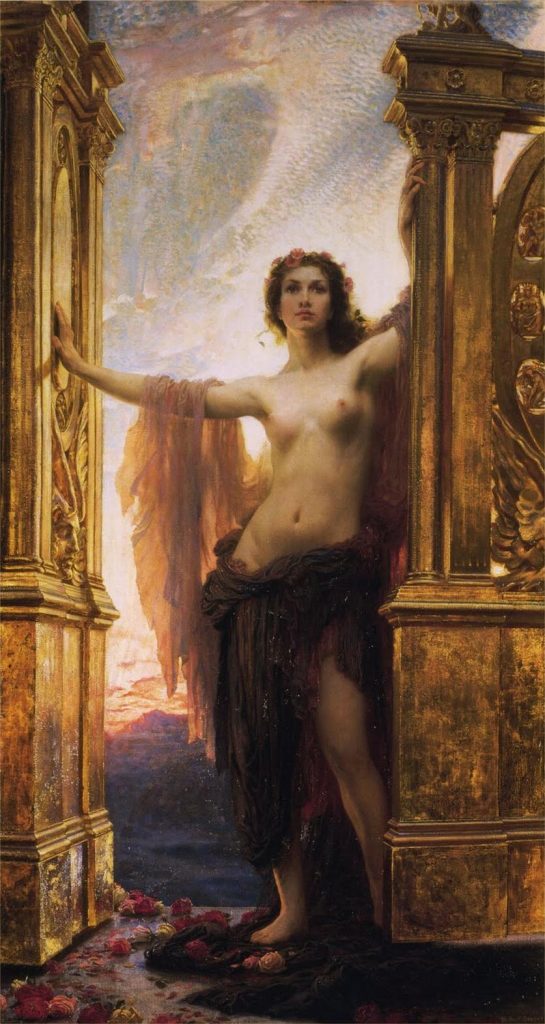
Powerful Women in Painting: Herbert James Draper, The Gates of Dawn, ca. 1900. Drapers Hall, London, UK. Wikimedia Commons (public domain).
Herbert James Draper was a successful English artist who was active in the late 19th century. For a significant part of his career, Draper was drawn to mythological scenes with an inclination for Greek legends. As the art consumers’ tastes changed, Draper began to focus on portraiture and gained public acclaim. From 1890 onwards, Draper regularly participated in annual expositions at the Royal Academy in London.
Here Draper depicts Eos, the Greek goddess of the Dawn (or Aurora, her Roman equivalent). As with several of his female subjects, Draper’s treatment of Eos is transcendent and majestic. Eos stands tall and proud, holding open majestic golden gates. Her form is depicted in the ethereal crimson light of dawn that illuminates her slender figure and casts her in a heavenly glow. The roses that adorn her hair and are scattered at her bare feet add a touch of floral charm to the composition. Draper’s Eos stands as a powerful sentinel over the promise of a new day behind her.
The Judge
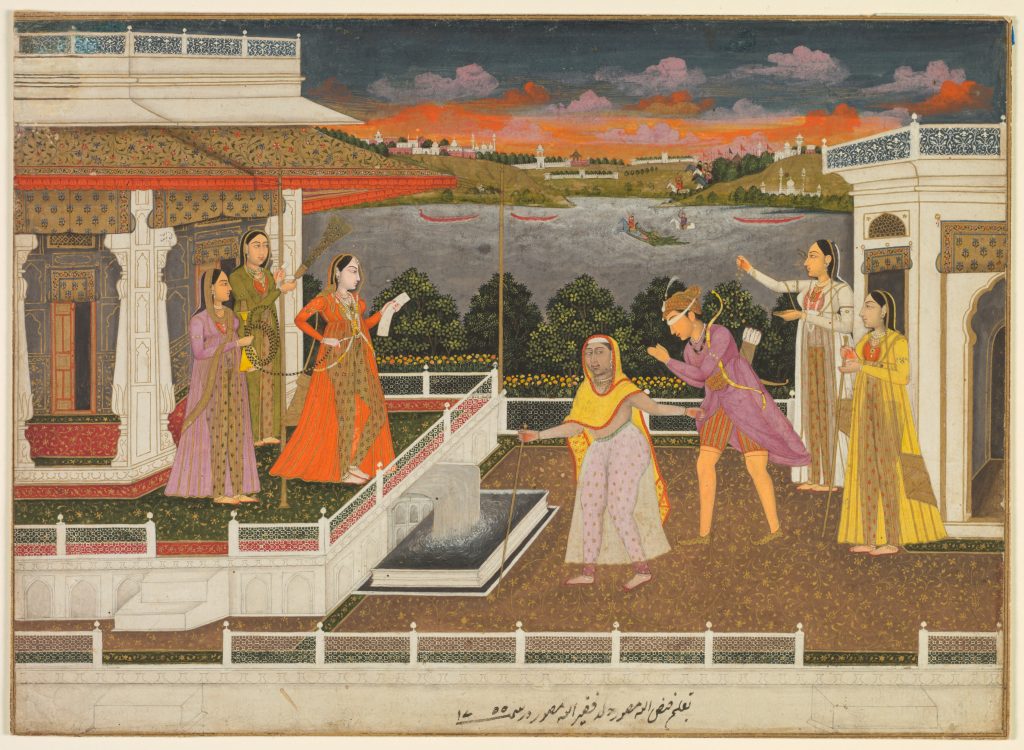
Powerful Women in Painting: Fayzullah, A Blindfolded Suitor is Brought Before a Princess (recto), ca. 1755, Cleveland Museum of Art, Cleveland, OH, USA.
Fayzullah was a painter in the royal Mughal atelier around the late 18th century, during the reign of Alamgir II. Although very little is known about Fayzullah’s personal life, the few identifiable paintings attributed to him demonstrate his incredible talent. This painting is exceptional for the intricate detail that has been conveyed on a relatively small scale.
The background of this artwork is rich with detailed architecture, foliage, and scenes of an impending battle, as well as a crocodile that is charging at soldiers on horseback in a large, murky body of water. However, the focus of the painting is on the richly carpeted terrace in the women’s section of the palace quarters that is depicted in the foreground. The painting features a traditional courtyard adorned with jaali-patterned railings and a water fountain sitting in the midst of a carefully orchestrated garden. It is a resplendent demonstration of the marquee features of the Mughal design. The traditional motifs are continued in the rich tapestry, carpets, and shamiana adorning the platform.
Within this platform is a vibrant scene in which an older woman of the harem presents to her mistress a blindfolded young man, likely a captive prince. This scene rendered by the royal atelier was likely an allusion not only to the literary acumen of the Mughal ladies but also to resonate with the circumstances at the Mughal court of the time, when powerful women wielded control over emperor Ahmad Shah Bahadur, resulting in their prominent role in the royal palaces.
The Mystery
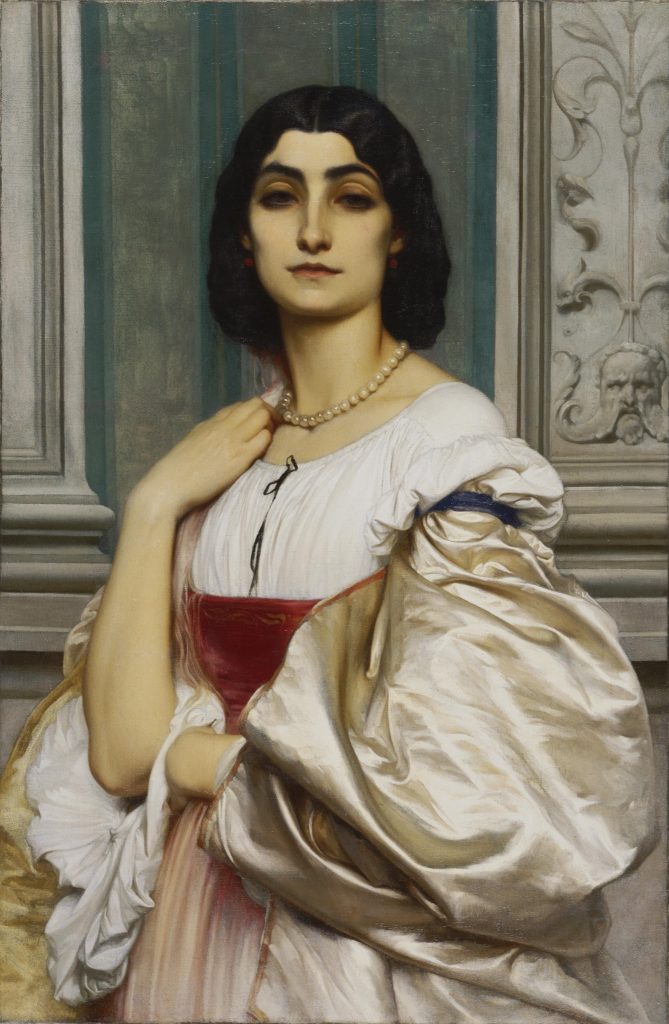
Powerful Women in Painting: Sir Frederic Leighton, A Roman Lady, ca. 1858, Philadelphia Museum of Art, Philadelphia, PA, USA.
Sir Frederic Leighton traveled to Rome for an extended visit in October 1858. He spent close to a year in Rome and his work from this period includes several paintings of Anna Risi or Nanna, a popular Italian model of the time.
There is no doubt as to the appeal of Risi as a model and muse. She appears sultry and poised, with a confident and mysterious gaze that is accentuated by the dark smoky shadows around her eyes and razor-sharp cheekbones. Leighton’s masterful portrayal of the fabric is also noteworthy and demonstrative of his talent. He depicts not only the fabric but differentiates between the cotton and the velvet bodice with the satin or taffeta of the luminous shawl draped around her slender form.
This composition evokes nostalgia for the Italian Renaissance while also celebrating the powerful female form of Anna Risi and her commanding presence. It was first exhibited in 1859 in London at the Royal Academy.
The Protectors
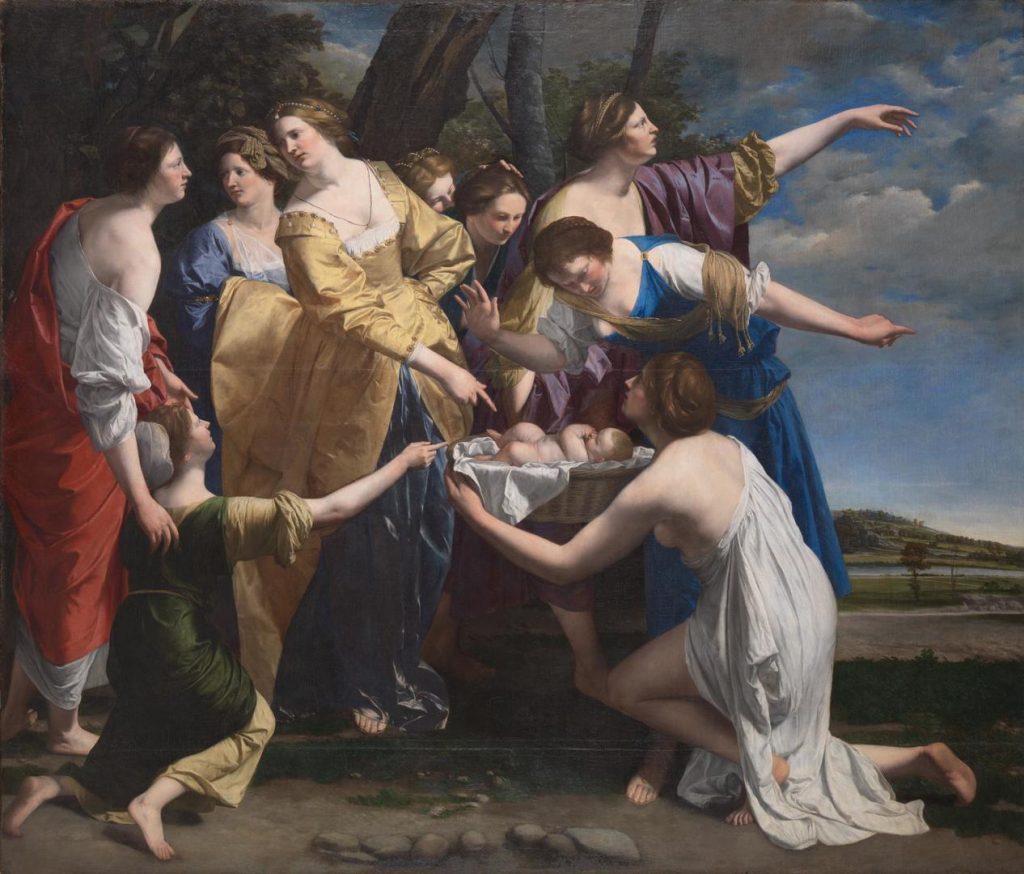
Powerful Women in Painting: Orazio Gentileschi, The Finding of Moses, ca. 1633, The National Gallery, London, UK.
Celebrated Italian painter Orazio Lomi Gentileschi was a 16th-century painter from Tuscany. (He was also father to the powerful feminist of art history, Artemisia Gentileschi.) In 1626, he moved to England at the behest of King Charles I and remained there for the rest of his life. The Finding of Moses was commissioned by King Charles I for his wife, Henrietta Maria to celebrate the birth of their son, the future Charles II.
This large composition depicts a tale from the Book of Exodus in the Old Testament, when the Pharaoh decreed the culling of all firstborn sons of Hebrews, and when the infant Moses was hidden away to ensure his safety.
Orazio Gentileschi depicts the Biblical episode with nine elegant female figures crowding around the prophesied infant. He expertly conveys the urgency of the moment and the collusion between the women on how best to protect the infant’s life. The power in this composition is in the valor of these women in their treasonous yet compassionate act of bravery to save the life of the foretold child.
The Queen
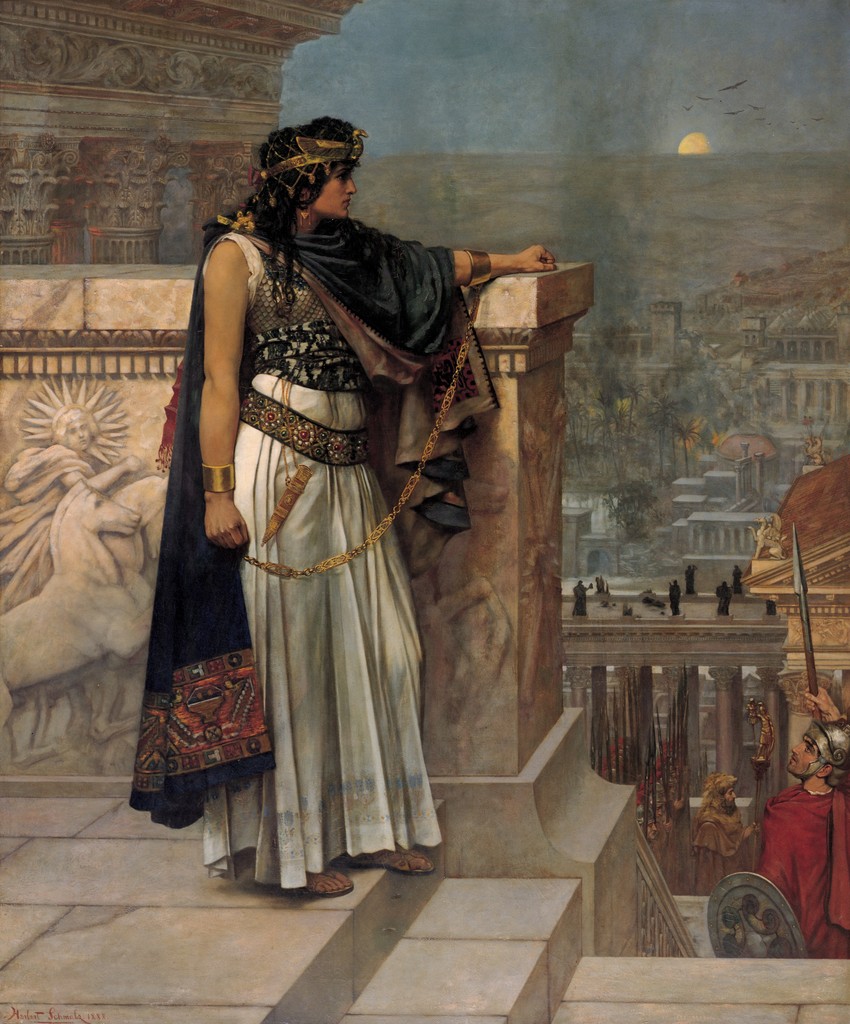
Powerful Women in Painting: Herbert Gustav Schmalz, Queen Zenobia’s Last Look Upon Palmyra, ca. 1888, Art Gallery of South Australia, Adelaide, Australia. Wikimedia Commons (public domain).
This painting is the work of Herbert Gustave Schmalz, later known as Herbert Carmichael. He was an English painter, known for his choice of historical themes. His trademark style was influenced by Orientalist and Pre-Raphaelite essences.
Here, the artist has rendered Septimia Zenobia. She was the rebellious ruler of the ancient city of Palmyra, a client state under Roman supremacy in the third century. Upon the death of her husband, Zenobia undertook an aggressive military campaign and annexed significant regions of the ancient Near East. While her reign lasted only a brief six years, her mark on history was solidified by her great ambitions, including the conquest of Egypt. She even briefly declared herself the Queen.
When Emperor Aurelian came into power in Rome, he launched a brief but effective campaign to quell the Palmyrene incursion. Legends state that Zenobia was captured and taken to Rome as a prisoner in chains. This painting depicts the final moments of Zenobia in her city of Palmyra. A Roman soldier is visible in the lower half of the foreground, gesturing to the Queen’s capture.
Schmalz’s depiction of Palmyra is incredibly detailed. It shows the depth of the classical architecture of the ancient city including rows of columns and intricate relief works. Furthermore, the setting sun in the background is an allegory for the end of Zenobia’s short-lived reign.
Despite her brief reign, Zenobia’s legacy continues to this day as the maverick Queen who defied the mighty Romans.
